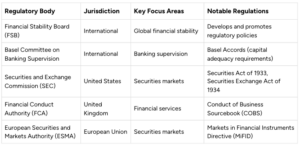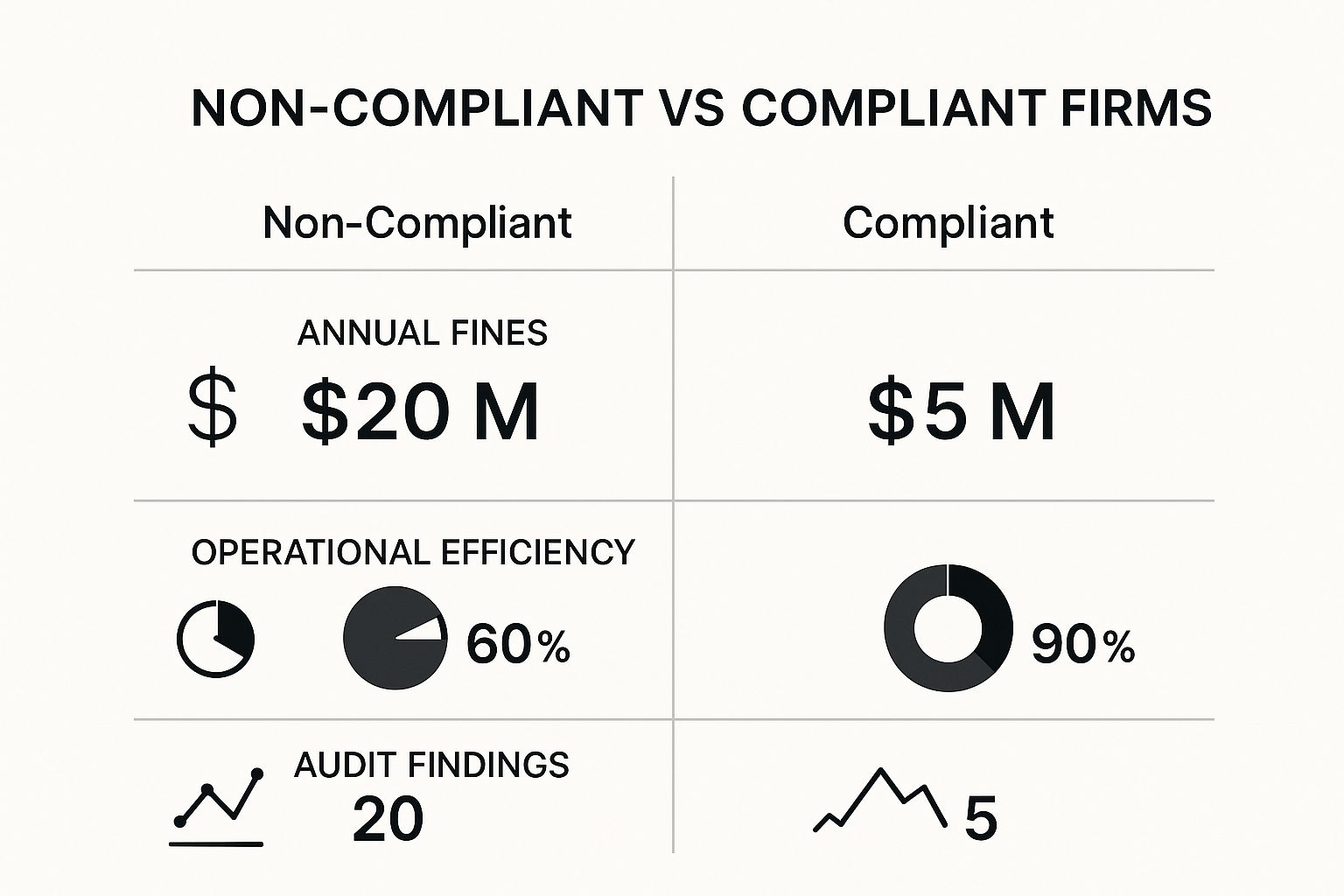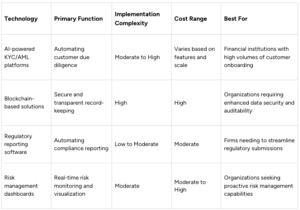Compliance in Financial Services Industry: Your Essential Guide
Published: May 20, 2025The Evolving Landscape of Financial Compliance
Financial compliance has shifted from a cost to a key strategy. New rules and global teamwork mean compliance is key. It builds trust, boosts efficiency, and drives innovation in finance.
What is Financial Compliance and Why Is It Strategic Now?
Financial compliance ensures institutions follow laws and rules for financial operations. In 2025, it’s not just a legal duty; it’s vital for business. Smart institutions weave compliance into their strategies. This helps them gain a competitive edge, build trust, and promote growth.
What Are the Real Costs of Non-Compliance?
-
Reputational Damage: It erodes trust from customers and investors.
-
Missed Opportunities: Regulatory breaches can lead to lost business.
-
Operational Disruptions: Legal issues can slow growth.
-
Financial Penalties: Fines and sanctions can be harsh.
The Shift Towards Proactive Compliance
The old reactive approach to compliance is fading. Now, a proactive model is on the rise. This means we should expect regulatory changes. We need to strengthen risk management and build a culture of compliance in the organization. This change comes from stricter rules, a focus on protecting consumers, and rapid tech growth.
In 2025, groups such as the Financial Stability Board (FSB) and the Basel Committee aim to standardize capital adequacy. This effort aims to stabilize the financial system and improve global regulatory cooperation. Being proactive reduces risks. It also creates chances for better efficiency. This leads to improved customer experiences and stronger business performance. Technology and automation can streamline compliance processes and provide insights into potential risks.
To understand the landscape better, let’s take a look at the key players involved in global financial regulation. The following table provides an overview:
Global Financial Regulatory Bodies
Overview of major regulatory authorities and their jurisdictions
This table highlights the different regulatory bodies responsible for overseeing financial markets across various jurisdictions. Each organization plays a vital role in maintaining stability and protecting investors and consumers.
Compliance as a Competitive Advantage
Top financial institutions are turning compliance from a cost center into a way to create value. By making compliance a core part of their business strategies, these institutions are building stronger relationships with customers, improving their reputations, and attracting and keeping the best employees. This approach also encourages innovation and boosts operational efficiency. In the end, a robust compliance framework sets a company apart in a competitive market.
Consumer Protection: Where Compliance Meets Opportunity
Consumer protection is no longer a secondary concern for financial service institutions. It’s a primary focus. This shift emphasizes the increasing importance of customer well-being and building trust. The UK’s Consumer Duty, for instance, is setting a new precedent for how financial institutions globally engage with their customers.
What Is the Consumer Duty and Why Does It Matter?
The Consumer Duty sets higher standards for firms. It pushes them to focus on what’s best for their customers. This means clear communication, fair pricing, and offering products that truly meet customer needs. While these standards can be challenging, they also present opportunities. Companies can use these rules to strengthen customer relationships and boost their brand image. The financial services industry is focusing more on compliance to protect consumers.
A key example is the Consumer Duty introduced by the UK Financial Conduct Authority (FCA) in 2023. It places a duty of care on firms toward their retail customers. This has gained global attention. Regulators in other countries, such as the Monetary Authority of Singapore (MAS), are also looking into similar rules. More statistics can be found here.
How Do You Implement Consumer-Centric Compliance?
To put the customer at the center of compliance, firms must shift their perspective. Financial institutions need to go beyond merely checking regulatory boxes. They must truly understand and meet customer needs. This may require redesigning products, reevaluating pricing, and improving communication clarity.
Effective implementation also requires strong internal processes and thorough training. This ensures employees can meet higher customer care standards. Understanding the broader regulatory landscape is vital. Firms need to know the legal rules for employee background checks in India.
Turning Compliance Into Opportunity
Adapting to these changes requires investment but also opens up significant opportunities. Putting consumer protection first can boost customer loyalty and trust. This helps a company shine in a crowded market.
This proactive approach can also lead to better long-term profits. Making products that truly meet customer needs can lower complaints and boost retention. This creates a positive cycle that benefits both consumers and businesses.
Building a Sustainable Future
Consumer-centric compliance goes beyond avoiding penalties. It’s about building a sustainable and ethical business. Financial institutions can ensure compliance and boost customer satisfaction with this approach.
This requires a commitment to transparency and accountability. It also needs a true desire to serve customers well. These values form the foundation for long-term success and contribute to a healthier financial ecosystem for all.
Technology Transformation in Compliance Operations
The infographic above highlights the significant differences between compliant and non-compliant firms. Compliant firms see fewer fines, improved operational efficiency, and fewer audit findings. This underscores the importance of investing in strong compliance practices and the right technologies. The growing complexity of regulations and the demand for efficient compliance processes are driving this shift. Financial institutions are increasingly adopting technology to meet these challenges and bolster their compliance operations.
The Rise of RegTech
RegTech, short for Regulatory Technology, refers to a range of technological solutions designed to simplify and automate compliance processes. These technologies utilize Artificial Intelligence (AI), blockchain, and advanced analytics to boost efficiency, reduce costs, and provide better insights into risk. This allows financial institutions to move away from manual, time-consuming tasks and concentrate on strategic decision-making.
Technological advancements, especially in cybersecurity and data protection, significantly impact the compliance landscape. In the PwC 2025 Global Compliance Survey, technology was a top compliance risk priority for respondents. Over 50% of executives cited cybersecurity and data privacy as major concerns, highlighting the increasing importance of digital trust in financial services.
Key RegTech Applications in Financial Services
Several key compliance areas are benefiting from RegTech solutions:
- Know Your Customer (KYC) and Anti-Money Laundering (AML): AI-powered solutions automate customer identification and verification, reducing manual work and increasing accuracy.
- Fraud Detection: Advanced analytics and machine learning algorithms detect suspicious patterns and transactions, allowing institutions to detect and prevent fraud more effectively.
- Regulatory Reporting: Automated reporting tools ensure accurate and timely submissions to regulatory bodies, minimizing penalties.
- Risk Management: Real-time monitoring and data visualization tools offer a comprehensive view of organizational risk, enabling proactive risk management.
To further illustrate the various RegTech solutions available, let’s examine a comparison of some common technologies:
Compliance Technology Solutions Comparison
Comparison of different technological solutions for compliance management
This table provides a snapshot of how various technologies address different compliance needs. Choosing the right solution depends on an institution’s specific requirements and resources.
Implementing RegTech: Challenges and Considerations
While RegTech has many benefits, it can be tough to implement:
-
Cost: New technology can be pricey, especially for smaller institutions.
-
Integration: Merging new systems with existing ones can be complex and time-consuming.
-
Talent: You need skilled professionals who understand both compliance and technology.
With careful planning and the right solutions, you can overcome these challenges. Assess your needs, evaluate your budget, and create a phased implementation plan. Blackbird offers a solution that automates compliance workflows. It reduces manual tasks and improves communication between investors and compliance teams.
As compliance needs change, technology will play a key role in managing risk. It protects the interests of financial institutions and their customers.
How to Build a Practical Compliance Framework
A solid compliance framework is vital in financial services. This guide will help you create a framework that meets today’s regulatory challenges while aligning with your business goals. It goes beyond simple checklists to form an integrated system.
Key Components of an Effective Compliance Framework
A solid compliance framework needs a well-rounded approach. This helps build a strong compliance culture:
-
Risk Assessment: Identify and evaluate your institution’s specific risks. Understand the regulatory landscape and your organization’s weaknesses. Proactive assessments help prioritize compliance efforts.
-
Policy Development: Develop clear policies that translate regulatory requirements into practical guidelines. Regular reviews and updates are crucial for staying compliant.
-
Training Programs: Provide comprehensive training to inform employees about their compliance responsibilities. Empowered employees make informed decisions and foster a compliance culture.
-
Compliance Team Structure: Organize your compliance team effectively. Establish clear roles, ensure adequate staffing, and promote open communication among departments.
-
Performance Measurement: Use relevant metrics to track compliance performance. This data highlights how effective your framework is and where improvements are needed. Stay updated on technology’s impact on the IRS. Check Technology Transforming The IRS for insights.
-
Culture of Compliance: Build a culture where everyone shares responsibility for compliance. This requires leadership commitment, consistent communication, and a focus on ethical decision-making.
Implementing and Maintaining the Framework
Creating a framework is just the start. Ongoing effort is needed for implementation and maintenance:
-
Communication: Regularly update staff on compliance requirements. This ensures everyone knows their role in maintaining compliance.
-
Monitoring and Testing: Continuously monitor and test the framework’s effectiveness. This helps identify gaps and allows for necessary adjustments.
-
Technology Integration: Use technology to automate tasks and enhance monitoring. This frees up compliance resources for strategic work.
-
Continuous Improvement: Review and update the framework often. Consider regulatory changes, industry best practices, and internal performance data.
Building a Culture of Compliance
A successful compliance framework relies on a strong culture of compliance. This needs buy-in from everyone, from senior management to all employees. When compliance is a shared responsibility, it becomes part of daily operations.
Financial institutions can build compliance frameworks by following these guidelines. This helps meet regulatory needs and boosts risk management, reputation, and performance. A proactive compliance strategy gives a competitive edge. It’s a smart investment in the organization’s future.
Mastering Cross-Border Compliance Challenges
Operating in financial services comes with inherent compliance challenges. These issues grow for global institutions. They must handle various regulations across different regions. Successfully managing international compliance requires careful planning and robust strategies.
Balancing Local Regulations With Global Standards
Multinational financial institutions face a big challenge. They balance local rules with global standards. Each jurisdiction has its own rules and expectations. Sometimes, these can conflict with the institution’s policies. This creates a complex web of requirements that can be hard to manage.
For instance, data privacy laws vary widely across countries. The EU’s General Data Protection Regulation (GDPR) has strict standards, while other regions may have more relaxed rules. Financial institutions must follow strict rules and adapt to local regulations. This often means adjusting data management practices. It also involves creating strong compliance programs that meet local needs.
Structuring Effective Cross-Border Compliance Teams
Creating effective compliance teams in a global context requires careful thought. A centralized compliance function can help ensure consistent policies across the organization. However, local compliance officers in each jurisdiction are essential. They understand local regulations and can interact effectively with local authorities.
This structure enhances communication between headquarters and local teams. Regular discussions help spot potential conflicts between local and global standards. It also fosters sharing best practices and knowledge, strengthening the entire compliance framework.
Leveraging Technology for Cross-Border Compliance
Technology is crucial for simplifying cross-border compliance. Solutions like Blackbird can automate tasks, such as KYC/AML checks and document management. This reduces manual effort, minimizes errors, and ensures consistency across jurisdictions.
Moreover, technology helps monitor regulatory changes in real-time. Staying informed about updates is vital for proactive compliance. It allows institutions to adapt quickly to new rules and avoid violations. This aids better risk management and identifies areas for improvement.
Financial institutions can tackle cross-border compliance challenges by being strategic. They should use technology and build strong compliance teams. This reduces risk and ensures long-term success. Strong compliance protects the institution. It also builds trust with clients and partners around the globe.
Measuring What Matters: Compliance Performance Metrics
Effective compliance in financial services depends on accurately measuring and tracking performance. Many institutions find it hard to look past basic metrics. This limits their ability to spot weaknesses and improve programs. Top organizations use data-driven methods and create KPIs. These metrics offer insights that lead to real change.
Quantitative Metrics: Objective Assessment
Quantitative metrics offer a clear view of compliance performance through measurable data. These metrics show how well an institution follows specific regulations and internal policies.
-
Compliance Violations Count: Keeping track of violations by type and severity shows where action is needed right away. A sudden rise in anti-money laundering (AML) violations may signal weaknesses in customer due diligence.
-
Time to Resolve Compliance Issues: Measuring the time to resolve issues is critical. Faster resolutions often indicate stronger compliance processes and a more proactive approach.
-
Cost of Compliance: Looking at compliance costs, such as technology, staffing, and training, helps us use resources wisely. It also shows stakeholders the value of compliance.
-
Customer Complaints About Compliance: Tracking complaints helps us understand customer experiences. It covers issues like data privacy breaches and unfair practices. This also reveals gaps in our procedures.
Qualitative Metrics: Capturing the Culture of Compliance
While quantitative metrics are essential, qualitative metrics capture the less tangible but equally critical aspects of compliance performance, like the overall culture of compliance.
- Employee Surveys: Regular surveys can assess employee understanding of policies, identify perceived barriers to compliance, and evaluate the ethical climate.
- Compliance Training Completion Rates: Tracking completion rates is a starting point. Analyzing employee feedback on training content and effectiveness gives a more complete picture of program quality.
- Internal Audit Findings: Internal audits offer a vital perspective on compliance program effectiveness, identifying weaknesses and areas for improvement in control design and operational effectiveness.
- Management Review of Compliance Performance: Regular reviews by senior management show leadership commitment and allow for assessment of program alignment with strategic goals.
Building Tailored Compliance Dashboards
Different stakeholders need different information. Compliance dashboards should be tailored for each audience.
- Compliance Teams: Detailed operational metrics are essential for daily monitoring and identifying trends. This helps prioritize tasks and quickly address issues.
- Senior Management: Executive summaries offer a high-level view of compliance performance, focusing on key risk indicators and strategic implications, enabling informed decisions about resources and program adjustments.
- Board of Directors: Concise reports highlighting key risks and the institution’s overall compliance posture are crucial for board oversight, promoting transparency and strong corporate governance.
The Future of Compliance Measurement: Advanced Analytics and Predictive Modeling
Advanced analytics and predictive modeling are reshaping compliance in financial services. These techniques help identify emerging risks before they occur. By analyzing historical data and patterns, institutions can predict potential breaches and act preventatively. Solutions like Blackbird automate compliance workflows, helping firms remain audit-ready and compliant. This proactive strategy reduces remediation costs and strengthens the entire compliance program. Data-driven insights empower compliance functions to continuously improve through informed decisions, ensuring adaptability in a dynamic regulatory environment. This proactive approach strengthens the institution’s risk management and contributes to long-term stability and success.


